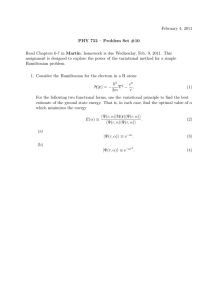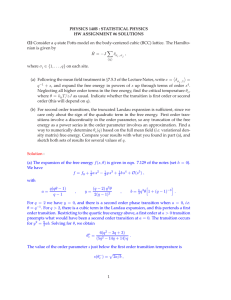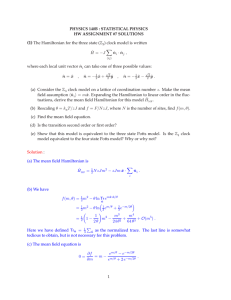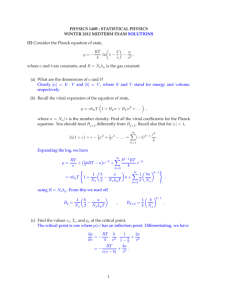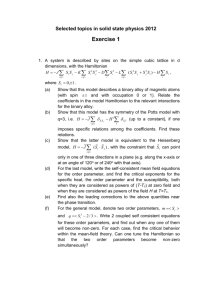(1)
advertisement
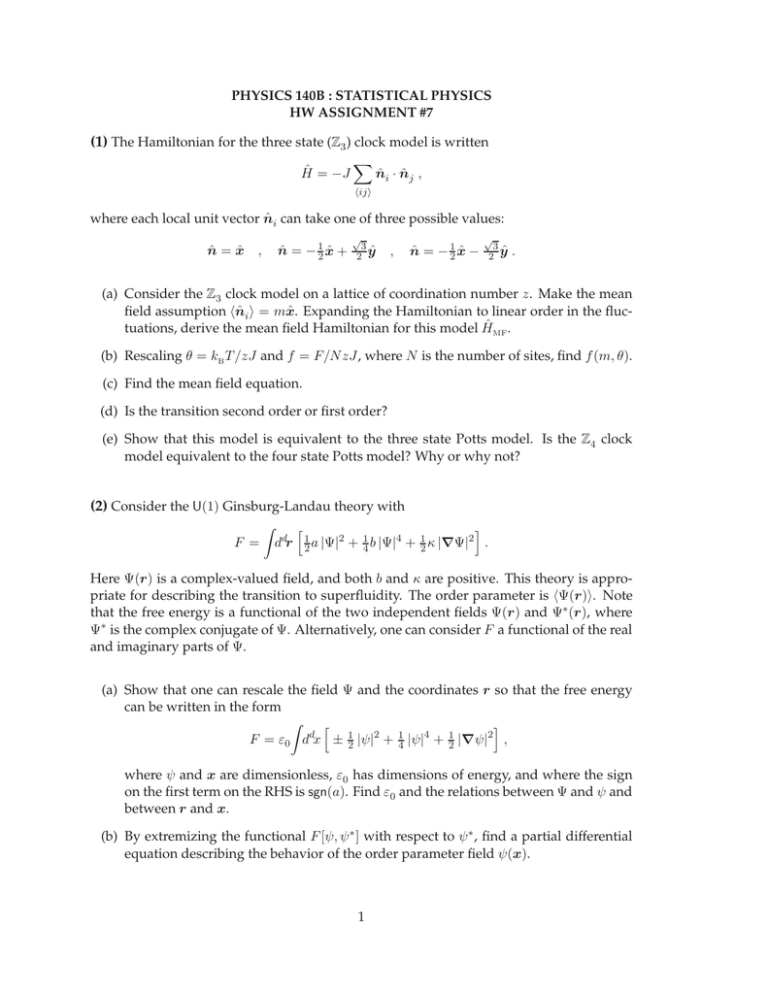
PHYSICS 140B : STATISTICAL PHYSICS HW ASSIGNMENT #7 (1) The Hamiltonian for the three state (Z3 ) clock model is written Ĥ = −J X hiji n̂i · n̂j , where each local unit vector n̂i can take one of three possible values: n̂ = x̂ n̂ = − 12 x̂ + , √ 3 2 ŷ , n̂ = − 21 x̂ − √ 3 2 ŷ . (a) Consider the Z3 clock model on a lattice of coordination number z. Make the mean field assumption hn̂i i = mx̂. Expanding the Hamiltonian to linear order in the fluctuations, derive the mean field Hamiltonian for this model ĤMF . (b) Rescaling θ = kB T /zJ and f = F/N zJ, where N is the number of sites, find f (m, θ). (c) Find the mean field equation. (d) Is the transition second order or first order? (e) Show that this model is equivalent to the three state Potts model. Is the Z4 clock model equivalent to the four state Potts model? Why or why not? (2) Consider the U(1) Ginsburg-Landau theory with F = Z ddr h 2 1 2 a |Ψ| i + 14 b |Ψ|4 + 12 κ |∇Ψ|2 . Here Ψ(r) is a complex-valued field, and both b and κ are positive. This theory is appropriate for describing the transition to superfluidity. The order parameter is hΨ(r)i. Note that the free energy is a functional of the two independent fields Ψ(r) and Ψ∗ (r), where Ψ∗ is the complex conjugate of Ψ. Alternatively, one can consider F a functional of the real and imaginary parts of Ψ. (a) Show that one can rescale the field Ψ and the coordinates r so that the free energy can be written in the form Z i h F = ε0 ddx ± 12 |ψ|2 + 14 |ψ|4 + 21 |∇ψ|2 , where ψ and x are dimensionless, ε0 has dimensions of energy, and where the sign on the first term on the RHS is sgn(a). Find ε0 and the relations between Ψ and ψ and between r and x. (b) By extremizing the functional F [ψ, ψ ∗ ] with respect to ψ ∗ , find a partial differential equation describing the behavior of the order parameter field ψ(x). 1 (c) Consider a two-dimensional system (d = 2) and let a < 0 (i.e. T < Tc ). Consider the case where ψ(x) describe a vortex configuration: ψ(x) = f (r) eiφ , where (r, φ) are two-dimensional polar coordinates. Find the ordinary differential equation for f (r) which extremizes F . (d) Show that the free energy, up to a constant, may be written as " ZR 2 f2 F = 2πε0 dr r 21 f ′ + 2 + 2r 0 1 4 1−f 2 2 # , where R is the radius of the system, which we presume is confined to a disk. Consider a trial solution for f (r) of the form f (r) = √ r2 r , + a2 where a is the variational parameter. Compute F (a, R) in the limit R → ∞ and extremize with respect to a to find the optimum value of a within this variational class of functions. 2
